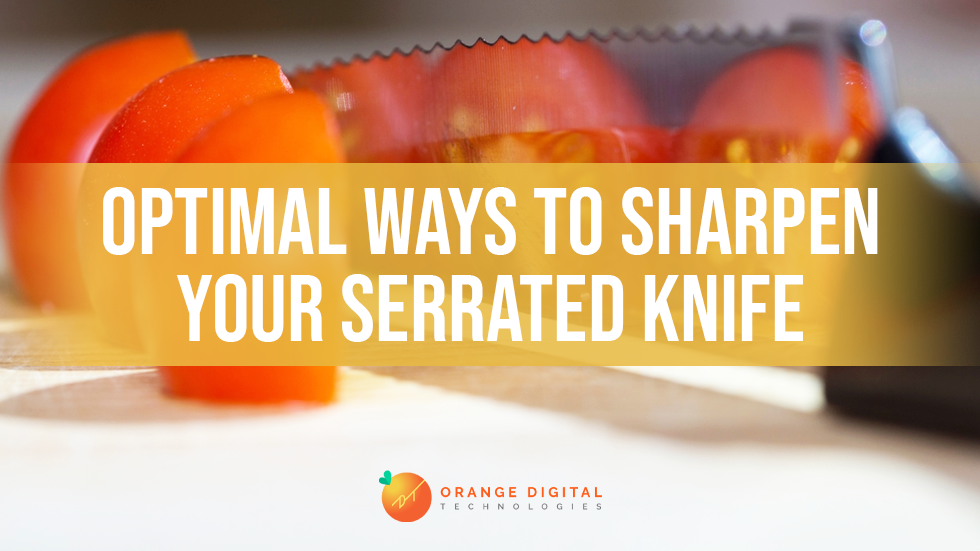Sharpening serrated knives differ from sharpening regular ones. Here are some surefire tips on how you can have your knife stay in top condition.
Sharpening knives, in general, is more complicated than how most people make it out to be because there needs to be a lot of factors to consider – angle, force, among others. Kitchen knives are fragile tools even though they’re made of hard steel. Additionally, their blades can quickly dull for every use, and mishandling them makes their blades blunt even faster.
On the other hand, serrated knives are knives with blades that have a chainsaw-like or toothed edge. And in comparison to other knives, how they cut is different since they’re intended to slice through thick, tough food without crushing its soft interior. This design makes serrated knives efficient for cutting specific types of food, but their rough edges also make sharpening them more complex than the rest.
How do You Sharpen Serrated Knives?
Whetstones are one of the best options to sharpen knives with straight edges. However, this material isn’t practical for serrated knives. Grinding them using whetstones alone might not be the optimal choice because of their toothed edge. Using whetstones on serrated knives will only flatten their serrations, making them more like regular knives, defeating their purpose. Here are a few details you should remember when it comes to sharpening your knives:
- Choose a low-maintenance serrated knife. Serrated knives can differ by the serrations on their blades.One with fewer serrations doesn’t necessarily offer lower performance. In fact, it does better at cutting and is easier to sharpen.
- Sharpen only when necessary. Unlike regular knives, serrated knives don’t need to be sharpened that often since even duller ones can still provide aid. Additionally, due to their toothed edges, most of their blades don’t make contact with cutting boards making it unnecessary to sharpen them regularly.
- Do the bread test. If you’re unsure if your knives need to be sharpened, you can test it by cutting bread. If you notice that the bread isn’t cut cleanly, leaving many crumbs, then it’s time to consider sharpening your knives.
Another detail to remember when sharpening these knives are the tools used that are unique to sharpening them:
Sharpening Rod
The sharpening rod is perhaps one of the most convenient tools you can use to sharpen a serrated knife. This rod is highly recommended since it provides the proper surface area for these serrated blades. To sharpen serrated knives using this, the rod’s diameter needs to fit in the serrated tips. Otherwise, the rod won’t be sharpening them. Choosing the perfect size of a sharpening rod for your serrated knife is also an essential process to avoid damaging your knife.
It would help to turn your knife’s blade, so the beveled edge faces you. One thing to note about serrated knives is that they have two sides – the beveled edge and the flat side. The bevel edge refers to the side that has been ground to shape the knife’s edge. The bevel is the angle or incline on either both or one side of your knife.
Sharpening Triangles
Sharpening triangles are a lot like sharpening rods, except that they’re on a fixed base. This serrated knife sharpener is triangle-shaped and is best for serrated knives with V-shaped rather than concave gullets. Sharpening knives using this is similar to how it is using a rod. You need to position the knife so that each of its gullets is adequately sharpened with short strokes. While sharpening your serrated knife, you might notice burrs forming from underneath. The presence of burrs is an excellent sign because it means that the sharpening agent is hard enough to carve the metal down.
But how do you check for a burr? For you to feel a burr, you need to gently place your thumb on the opposite side of the blade that was touching or in contact with the sharpening stone. Afterward, you need to slide your thumb away from that edge. Remember to move in a perpendicular manner to the edge and never along it. A burr is the bit of metal forming on that edge. You can feel it as you move over the edge. Its presence indicates that you’ve sharpened the edge. In contrast, the absence of a burr indicates that you’re striking your blade at a shallow angle. With this, you need to either sharpen behind the edge or correct your angle and sharpen more.


0 Comments